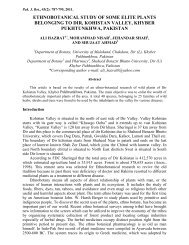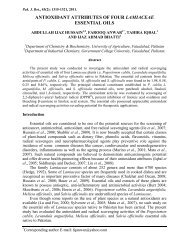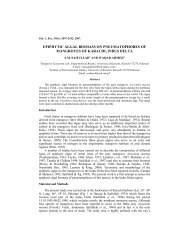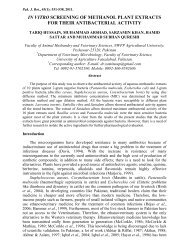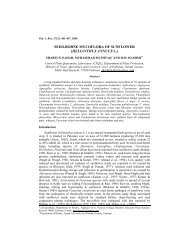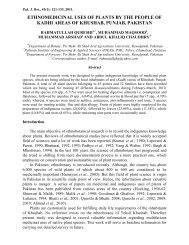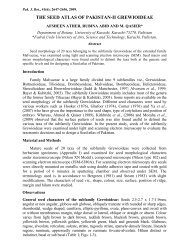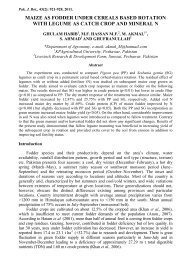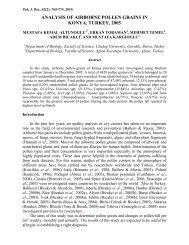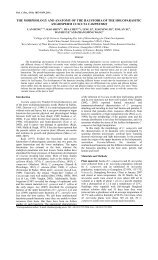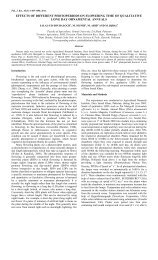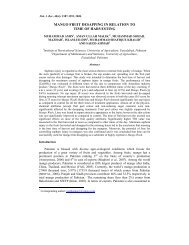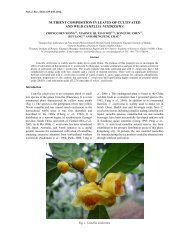Nutritional evaluation of herbs as fodder source for ruminants
Nutritional evaluation of herbs as fodder source for ruminants
Nutritional evaluation of herbs as fodder source for ruminants
You also want an ePaper? Increase the reach of your titles
YUMPU automatically turns print PDFs into web optimized ePapers that Google loves.
Pak. J. Bot., 41(6): 2765-2776, 2009.<br />
NUTRITIONAL EVALUATION OF HERBS AS FODDER<br />
SOURCE FOR RUMINANTS<br />
JAVED IQBAL SULTAN 1* , INAM-UR-RAHIM 1 , MUHAMMAD YAQOOB 2 ,<br />
M.I. MUSTAFA 2 , HAQ NAWAZ 1 AND PERVEZ AKHTAR 3<br />
1 Institute <strong>of</strong> Animal Nutrition and Feed Technology, University <strong>of</strong> Agriculture,<br />
Faisalabad-38040, Pakistan<br />
2 Department <strong>of</strong> Livestock Management, University <strong>of</strong> Agriculture, Faisalabad, Pakistan<br />
3 Department <strong>of</strong> Animal Breeding and Genetics, University <strong>of</strong> Agriculture,<br />
Faisalabad, Pakistan.<br />
Abstract<br />
This study augmented the <strong>evaluation</strong> <strong>of</strong> <strong>herbs</strong> <strong>as</strong> <strong>fodder</strong> <strong>source</strong> <strong>for</strong> <strong>ruminants</strong>. Eleven <strong>herbs</strong><br />
species viz., Denothera vosea, Athyrium acrotiochoides, Chenopodium album, Polygonum<br />
amplexicaule, Atrimisia maritima, Oriosma lispidum, Cynoglossum lanceolatum, Plantago ovata,<br />
Hackalia macrophyla, Lespedeza spp., Urtica dioka were selected and analyzed <strong>for</strong> dry matter<br />
(DM), organic matter (OM), <strong>as</strong>h, crude protein (CP), neutral detergent fiber (NDF), acid detergent<br />
fiber (ADF), hemi-cellulose, and lignin contents. The average values <strong>for</strong> DM, OM, <strong>as</strong>h, CP, NDF,<br />
ADF, hemi-cellulose and lignin were 27.5±1.66, 24.2±1.33, 11.6±0.96, 12.3±1.42, 56.7±1.87,<br />
30.9±1.24, 25.8±1.42 and 4.4±0.42, respectively. The average values <strong>for</strong> Ca, P, K and Mg at were<br />
0.62±0.066, 0.033±0.003, 0.85±0.118, and 0.012±0.002, respectively and average values <strong>for</strong> Cu,<br />
Zn, Mn and Co were 24.59±5.439, 22.64±3.314, 12.18±1.757 and 0.049±0.008, respectively. In<br />
species, the highest (p
2766<br />
JAVED IQBAL SULTAN ET AL.,<br />
Herbs leaves are an alternative <strong>source</strong> <strong>of</strong> livestock feeding in scarcity period,<br />
specially in prolonged winter. The <strong>herbs</strong> leaves are harvested from protected hillside<br />
rangelands and are stored <strong>as</strong> hay. Herbs from ranges and uneven are<strong>as</strong> are also harvested<br />
several times during summer and are fed to livestock. Rangeland gr<strong>as</strong>ses are, although<br />
the main way <strong>of</strong> procuring feed, yet <strong>herbs</strong> play an important role in livestock raising<br />
(Qureshi et al., 1993). As there is little in<strong>for</strong>mation regarding the nutritive value <strong>of</strong><br />
locally available <strong>herbs</strong> so the study w<strong>as</strong> conducted to establish the nutritive value <strong>of</strong> the<br />
different species <strong>of</strong> <strong>herbs</strong> <strong>of</strong> northern gr<strong>as</strong>slands <strong>of</strong> Pakistan.<br />
Materials and Methods<br />
Study site: This study w<strong>as</strong> conducted in North Trans-Himalayan moist zone occupying<br />
Malakand Division, North Western Frontier Province (NWFP), Pakistan. The study area<br />
h<strong>as</strong> a humid subtropical to temperate environment. It extends from “Budhal” foothills (up<br />
to 800 meters altitude) in the south to “Burha Banr” in the north and northe<strong>as</strong>t (more than<br />
2000 meters altitude). Total surface area is approximately 209 square kilometer, with<br />
north and south parts divided by a mountain ridge known <strong>as</strong> “Sar Qala”. The annual<br />
precipitation varies from 600 to 1000 mm, mainly during summer and spring. In general<br />
the irrigated agriculture in the area is confined to the narrow valley bottom and adjoining<br />
gentle slopes. The gentle slopes on mid hills are mainly used <strong>for</strong> rain fed (Barani)<br />
agriculture. The medium to steep hill slopes near the residences and gentle to medium hill<br />
slopes away from the residences are protected during wet summer se<strong>as</strong>on <strong>for</strong> <strong>for</strong>age<br />
harvest. The <strong>for</strong>age is harvested at a mature stage during early autumn and fed <strong>as</strong> hay to<br />
the wintering livestock. The steeper hill slopes near the residences are generally used <strong>for</strong><br />
free grazing by settled livestock throughout the year. The steeper slopes away from<br />
residences are generally scrub/bush lands and natural <strong>for</strong>est mostly grazed by nomadic<br />
sheep and goat flocks. The lower elevation rangelands are grazed during winter se<strong>as</strong>on<br />
and by nomadic flocks, while tracking to and fro <strong>of</strong> alpine p<strong>as</strong>tures graze the upper<br />
elevation rangelands.<br />
Identification and sampling <strong>of</strong> <strong>fodder</strong> <strong>herbs</strong> species: To achieve this <strong>as</strong>pect, a<br />
questionnaire w<strong>as</strong> prepared and the farmers <strong>of</strong> various social groups at three elevations<br />
i.e., upper, middle and lower elevations were interviewed. They were <strong>as</strong>ked about the<br />
names <strong>of</strong> <strong>herbs</strong> in local language (P<strong>as</strong>htu), their se<strong>as</strong>on <strong>of</strong> use, location, elevations and<br />
<strong>as</strong>pects <strong>of</strong> their availability, species <strong>of</strong> animal fed and trends in their frequency. Ninety<br />
farmers (30 x 3, at each elevation) were interviewed in 9 villages (3 x 3, villages at each<br />
elevation). B<strong>as</strong>ed on the in<strong>for</strong>mation generated by the farmers through the questionnaire,<br />
the samples <strong>of</strong> different <strong>herbs</strong> species were collected and their specimens were sent to<br />
Pakistan Forest Institute, Peshawar, Pakistan <strong>for</strong> botanical identification. Eleven<br />
commonly available <strong>herbs</strong> species were harvested and air-dried and stored in polythene<br />
bags <strong>for</strong> further analysis.<br />
Chemical analysis: The air-dried <strong>herbs</strong> leaves samples were further dried in a hot air<br />
oven at 60°C and were analyzed <strong>for</strong> dry matter (DM), organic matter (OM), <strong>as</strong>h and<br />
nitrogen (Anon., 1990). Samples <strong>of</strong> <strong>herbs</strong> leaves were also analyzed <strong>for</strong> neutral detergent<br />
fiber, (NDF) acid detergent fiber (ADF), hemi-cellulose and lignin (Van Soest &<br />
Robertson, 1990).
NUTRITIONAL EVALUATION OF HERBS FOR RUMINANTS 2767<br />
Palatability <strong>of</strong> <strong>herbs</strong> leaves: Four mature local sheep <strong>of</strong> average body weight 40 kg were<br />
procured from the local market and they were drenched <strong>for</strong> internal par<strong>as</strong>ites. The sheep<br />
were adapted <strong>for</strong> five week to the dry leaves, trained in the experimental procedure by<br />
<strong>of</strong>fering the test samples to them alone or in pairs daily. During preliminary periods animal<br />
were fed a diet consisted <strong>of</strong> 80% mixed dry leaves and 20% concentrate mixture. This diet<br />
had 10% crude protein (CP) and 8.37 MJ/kg metabolizable energy (ME). The mineral<br />
mixture w<strong>as</strong> also added in the diet to meet the sheep requirement (Anon., 1985). The<br />
potential intake rate (PIR) <strong>for</strong> different <strong>herbs</strong> leaves w<strong>as</strong> determined through the procedure<br />
adopted by Rehman (1995). The leaves <strong>of</strong> each herb species w<strong>as</strong> <strong>of</strong>fered to sheep <strong>for</strong> a set<br />
<strong>of</strong> comparisons consisting <strong>of</strong> four consecutive periods <strong>of</strong> one minute duration each at ten<br />
minutes interval. Sheep were <strong>of</strong>fered <strong>herbs</strong> leaves in pl<strong>as</strong>tic containers ensuring that part <strong>of</strong><br />
<strong>for</strong>age w<strong>as</strong> left over after one minute <strong>of</strong> intake. Relative preference (RP) w<strong>as</strong> also evaluated<br />
in 95 days through the procedure used by Sultan et al., (2008). The preference ranking <strong>of</strong><br />
<strong>herbs</strong> leaves within each group w<strong>as</strong> determined by <strong>of</strong>fering <strong>fodder</strong> <strong>of</strong> <strong>herbs</strong> leaves in pairs,<br />
initially with the <strong>for</strong>age having highest PIR and then with other <strong>for</strong>ages, until all possible<br />
combinations within a group w<strong>as</strong> studied and similarly all <strong>herbs</strong> leaves were studied. Like<br />
PIR, RP test also consisted <strong>of</strong> a set <strong>of</strong> four consecutive period <strong>of</strong> one-minute duration each<br />
at ten minutes interval. There w<strong>as</strong> one-hour gap be<strong>for</strong>e a new set <strong>of</strong> comparisons w<strong>as</strong><br />
started with a maximum <strong>of</strong> four sets in a day. The containers <strong>of</strong> both <strong>for</strong>ages in a pair were<br />
reversed <strong>for</strong> each successive comparison to avoid left or right hand bi<strong>as</strong>. The preference <strong>for</strong><br />
particular <strong>for</strong>age w<strong>as</strong> determined by the standard procedure <strong>for</strong> two choice tests (Bell,<br />
1959), <strong>as</strong> the intake <strong>of</strong> <strong>herbs</strong> leaves expressed <strong>as</strong> a percentage <strong>of</strong> the combined intake <strong>of</strong><br />
both test and standard <strong>for</strong>age.<br />
Relative preference (RP) % =<br />
Amount <strong>of</strong> test <strong>for</strong>age eaten<br />
Amount <strong>of</strong> test + standard <strong>for</strong>age eaten<br />
X100<br />
In vitro dry matter digestibility (IVDMD) and metabolizable energy (ME) MJ/kg<br />
DM: For the IVDMD determination, oven dried ground samples were incubated at<br />
37±1°C <strong>for</strong> 48 hours between pH 6.7-7.0 in an all gl<strong>as</strong>s system using 45 ml <strong>of</strong> inoculums.<br />
The inoculums comprised <strong>of</strong> 36 ml <strong>of</strong> McDougal’s artificial saliva and 9.0 ml <strong>of</strong> strained<br />
fresh rumen liquor collected from ruminally fistulated buffaloes. After incubation and<br />
centrifugation the residue w<strong>as</strong> then treated <strong>for</strong> 48 hours with pepsin in weak acid (pH<br />
2.0). The final residue w<strong>as</strong> composed <strong>of</strong> undigested plant cell wall and bacterial debris<br />
and yield values were supposed to be comparable to in vivo apparent digestibility (Tilley<br />
& Terry, 1963). The IVDMD w<strong>as</strong> used <strong>for</strong> calculating the metabolizable energy (ME) <strong>of</strong><br />
<strong>herbs</strong> leaves species by the following equation (Anon., 1984):<br />
ME (MJ/kg DM)= 0.15 IVDMD%<br />
IVDMD% = 0.98 IVDMD% - 4.8<br />
The average values <strong>for</strong> chemical composition, structural constituents, IVDMD and<br />
ME were integrated to develop a matrix <strong>of</strong> correlation (Steel et al., 1997).
2768<br />
Results and Discussion<br />
JAVED IQBAL SULTAN ET AL.,<br />
Chemical and structural constituents: The chemical fractions <strong>of</strong> <strong>fodder</strong> <strong>herbs</strong> are<br />
depicted in Table 1. The DM contents <strong>of</strong> various <strong>herbs</strong> used <strong>for</strong> feeding livestock in the<br />
study area varied from 20.1 to 34.8% and the mean w<strong>as</strong> 27.5±1.66%. The highest DM<br />
value w<strong>as</strong> observed <strong>for</strong> Urtica dioka followed by Cynoglossum lanceolatum and Oriosma<br />
lispidum, respectively. The lowest value w<strong>as</strong> observed <strong>for</strong> Chenopodium album (Table 1).<br />
The OM contents ranged from 18.4 to 31.7% and the mean w<strong>as</strong> 24.2±1.33%. The highest<br />
OM value w<strong>as</strong> observed <strong>for</strong> Urtica dioka followed by Cynoglossum lanceolatum and<br />
Lespedeza spp., respectively, and the lowest value w<strong>as</strong> observed <strong>for</strong> Chenopodium album.<br />
The <strong>as</strong>h contents varied from 7.5 to 16.2% and the mean w<strong>as</strong> 11.6 ± 0.96%. The<br />
highest <strong>as</strong>h value w<strong>as</strong> <strong>for</strong> Oriosma lispidum followed by Cynoglossum lanceolatum and<br />
Artimisia maritina, respectively. The lowest value w<strong>as</strong> observed <strong>for</strong> Denothera vosea.<br />
The CP contents <strong>of</strong> <strong>fodder</strong> <strong>herbs</strong> varied from 8.9 to 24.9% and the mean w<strong>as</strong><br />
12.3±1.42%. The highest CP value w<strong>as</strong> observed <strong>for</strong> Chenopodium album followed by<br />
Polygonum amplexicaule and Denothera vosea, respectively. The lowest value w<strong>as</strong><br />
observed <strong>for</strong> Urtica dioka. Distel et al., (2005) reported that CP contents in different<br />
<strong>for</strong>rage species declined with time. Similar findings were reported by Verma et al.,<br />
(1982) who reported a decline in CP contents <strong>of</strong> tree leaves from 6.9 to 28.8% on DM<br />
b<strong>as</strong>is in mature leaves <strong>of</strong> <strong>for</strong>age plants.<br />
Structural constituents in <strong>fodder</strong> <strong>herbs</strong> are presented in Table 2, the NDF contents <strong>of</strong><br />
11 commonly found <strong>fodder</strong> <strong>herbs</strong> varied between 49 to 67% and the mean w<strong>as</strong><br />
56.7±1.87%. The highest value w<strong>as</strong> observed <strong>for</strong> Urtica dioka followed by Hackalia<br />
macrophyla and Cynoglossum lanceolatum, respectively. The lowest value w<strong>as</strong> observed<br />
<strong>for</strong> Alhyrium acrotichoides.The ADF contents varied between 24 to 38% and the mean<br />
w<strong>as</strong> 30.9±1.24%. The highest value w<strong>as</strong> observed <strong>for</strong> Urtica dioka followed by Hackalia<br />
macrophyla and Cynaglossum lanceolatum, respectively. The lowest value w<strong>as</strong> observed<br />
<strong>for</strong> Denothera vosea.<br />
The hemi-cellulose concentration varied between 20 to 33% and the mean w<strong>as</strong><br />
25.8±1.42%. The highest hemi cellulose value w<strong>as</strong> observed <strong>for</strong> Atrimisia marilina<br />
followed by Denothera vosea and Hackalia macrophyla, respectively. The lowest hemi<br />
cellulose value w<strong>as</strong> observed <strong>for</strong> Polygonum amplexicaule and Alhyrium acrotichoides.<br />
The lignin concentration w<strong>as</strong> in the range <strong>of</strong> 2.8 to 7.5% and the mean w<strong>as</strong> 4.4±0.42%.<br />
The highest value w<strong>as</strong> observed <strong>for</strong> Urtica dioka followed by Hackalia macrophyla and<br />
Lespedeza spp., respectively. The lowest value w<strong>as</strong> observed <strong>for</strong> Chenopodium album.<br />
The NDF, ADF and lignin contents were lower in vegetative leaves than mature<br />
leaves, indicating relatively smaller stem proportion in the anatomy <strong>of</strong> vegetative leaves.<br />
All the structural constituents (NDF, ADF, hemi-cellulose and lignin) incre<strong>as</strong>ed in mature<br />
leaves. According to Cherney et al., (1993), the tropical <strong>for</strong>ages generally showed an<br />
incre<strong>as</strong>e in structural constituents with incre<strong>as</strong>ing maturity. Bourquin et al., (1994)<br />
reported 72.4% NDF and 43.8% ADF in the orchard gr<strong>as</strong>s on DM b<strong>as</strong>is. Sanderson et al.,<br />
(1989) observed a difference <strong>of</strong> 3l.4 to 66.8% in NDF contents <strong>of</strong> alfalfa in two different<br />
years. In stem <strong>of</strong> alfalfa, the NDF concentration ranged from 21 to 68%. According to<br />
Cherney et al., (1990) NDF and ADF tended to be lower in inflorescence than in other<br />
morphological components. They also reported higher ADF in stem than in blade and<br />
sheath <strong>of</strong> leaves.<br />
The findings <strong>of</strong> this study were in line with those <strong>of</strong> Cherney et al., (1993) who also<br />
reported an incre<strong>as</strong>e in all fiber constituents with incre<strong>as</strong>ing maturity. They reported that<br />
lignin w<strong>as</strong> proportionately higher in stem than other parts <strong>of</strong> the plants. Brown et al.,<br />
(1984) reported that the soil fertility also influenced gr<strong>as</strong>s lignin concentration.
NUTRITIONAL EVALUATION OF HERBS FOR RUMINANTS 2769<br />
Table l. Chemical fractions <strong>of</strong> <strong>herbs</strong> found in Northern gr<strong>as</strong>slands <strong>of</strong> Pakistan.<br />
Name <strong>of</strong> herb<br />
DM<br />
%<br />
OM<br />
%<br />
ASH<br />
%<br />
CP<br />
%<br />
Denothera vosea 21.1 19.5 7.5 13.2<br />
Athyrium acrotichoides 22.5 20.3 9.8 9.3<br />
Chenopodium album 20.1 18.4 8.4 24.9<br />
Polygonum amplexicaule 26.2 22.7 13.4 16.4<br />
Atrimisia maritima 30.4 26.0 14.6 10.5<br />
Oriosma lispidum 32.2 27.0 16.2 9.5<br />
Cynoglossum lanceolatum 34.5 29.0 15.9 11.7<br />
Plantago ovata 22.6 20.7 8.3 9.6<br />
Hackalia macrophyla 26.6 23.2 12.6 12.5<br />
Lespedeza spp. 31.8 28.0 11.9 9.3<br />
Urtica dioka 34.8 31.7 9.0 8.9<br />
Mean ± SE 27.5 ± 1.66 24.2 ± 1.33 11.6 ± 0.96 12.3 ± 1.42<br />
Table 2. Structural constituents in <strong>herbs</strong> found in Northern gr<strong>as</strong>slands <strong>of</strong> Pakistan.<br />
Name <strong>of</strong> herb<br />
NDF<br />
%<br />
ADF<br />
%<br />
Hemi cellulose<br />
%<br />
Lignin<br />
%<br />
Denothera vosea 56 24 32.0 3.5<br />
Athyrium acrotichoides 49 29 20.0 3.2<br />
Chenopodium album 51 29 22.0 2.8<br />
Polygonum amplexicaule 53 33 20.0 3.4<br />
Atrimisia maritima 60 27 33.0 4.6<br />
Oriosma lispidum 51 28 23.0 2.9<br />
Cynoglossum lanceolatum 62 34 28.0 4.5<br />
Plantago ovata 53 30 23.0 3.8<br />
Hackalia macrophyla 66 36 30.0 5.9<br />
Lespedeza spp. 56 32 24.0 4.8<br />
Urtica dioka 67 38 29 7.5<br />
Mean ± SE 56.7± 1.87 30.9 ± 1.24 25.8 ± 1.42 4.4 ± 0.42<br />
Table 3. Mineral composition <strong>of</strong> <strong>herbs</strong> found in Northern gr<strong>as</strong>slands <strong>of</strong> Pakistan.<br />
Name <strong>of</strong> herb<br />
Ca<br />
%<br />
P<br />
%<br />
K<br />
%<br />
Mg<br />
%<br />
Cu<br />
ppm<br />
Zn<br />
ppm<br />
Mn<br />
ppm<br />
Co<br />
ppm<br />
Denothera vosea 0.46 0.044 1.01 0.01 30.0 9.6 6.0 0.068<br />
Athyrium acrotichoides 0.64 0.036 0.62 0.011 20.0 25.2 6.00 0.061<br />
Chenopodium album 0.49 0.018 0.98 0.009 23.5 18.4 13.0 0.026<br />
Polygonum amplexicaule 1.08 0.040 0.31 0.016 12.5 16.9 24.0 0.049<br />
Atrimisia maritima 0.74 0.032 0.37 0.03 15.0 38.9 17.0 0.035<br />
Oriosma lispidum 0.74 0.018 1.27 0.11 32.5 38.3 16.0 0.087<br />
Cynoglossum lanceolatum 0.82 0.020 0.47 0.009 14.5 14.4 12.0 0.023<br />
Plantago ovata 0.42 0.041 0.99 0.013 75.0 31.1 17.0 0.093<br />
Hackalia macrophyla 0.36 0.034 0.85 0.005 15.0 14.5 8.0 0.014<br />
Lespedeza spp. 0.36 0.047 1.62 0.007 20.0 32.2 7.0 0.053<br />
Urtica dioka 0.70 0.029 0.86 0.007 12.5 9.5 8.0 0.025<br />
Mean ± SE<br />
0.62<br />
±0.066<br />
0.033<br />
±0.003<br />
0.85<br />
±0.118<br />
0.012<br />
±0.002<br />
24.59<br />
±5.439<br />
22.64<br />
±3.314<br />
12.18<br />
±1.757<br />
0.049<br />
±0.008<br />
Mineral composition <strong>of</strong> <strong>herbs</strong>: The mineral composition <strong>of</strong> <strong>herbs</strong> is presented in<br />
Table 3. The Ca concentration in <strong>herbs</strong> varied from 0.36% (Hackalia macrophyla,<br />
Lespedeza spp.) to 1.08% (Polygonum amplexicaule) and mean w<strong>as</strong> 0.62±0.066%. The
2770<br />
JAVED IQBAL SULTAN ET AL.,<br />
findings <strong>of</strong> present study revealed that Ca content in <strong>herbs</strong> generally incre<strong>as</strong>ed with<br />
maturity. Optimum level <strong>of</strong> Ca in plants ranged from 0.40 to 0.60% and its level above<br />
1.0% is considered high (Georgievskii, 1982, Khan et al., 2005, Khan et al., 2007),<br />
where<strong>as</strong>, Minison (1990) reported Ca level from 0.31 to 1.98% and the mean <strong>as</strong> 0.63%.<br />
On the other hand Ca level in the diet <strong>of</strong> livestock to fulfill its maintenance and<br />
production requirements should remain within the range <strong>of</strong> 0.17 to 0.42% (Anon., 1975).<br />
The variation noted within the present gr<strong>as</strong>ses w<strong>as</strong> in line with previous studies (Skerman<br />
& Riveros 1990; Gohl, 1981).<br />
Phosphorus concentration in <strong>herbs</strong> varied from 0.018% (Chenopodium album,<br />
Oriosma lispidum) to 0.047% (Lespedeza spp.) and the mean w<strong>as</strong> 0.033±0.003%. The P<br />
content incre<strong>as</strong>ed with age in <strong>herbs</strong>. The consistent low phosphorus content across all<br />
vegetation might be due to low P content in the soil or high Ca in the soil. These results<br />
differed from those <strong>of</strong> Minson (1990) who reported declined P content with advancing<br />
age <strong>of</strong> the plants. The P content in tropical gr<strong>as</strong>ses varied from 0.02 to 0.06% <strong>of</strong> plant dry<br />
matter and this variation might be due to available P in the soil (Skerman & Riveros,<br />
1990). These results revealed that P concentration in various <strong>for</strong>ages w<strong>as</strong> below the<br />
minimum requirement (0.082%) <strong>of</strong> livestock (Anon., 1975). These results also supported<br />
the findings <strong>of</strong> Sprague (1979) who reported that P w<strong>as</strong> widely deficient in soils <strong>of</strong><br />
rangelands in semi-arid and sub humid regions and consequently in the gr<strong>as</strong>ses grown in<br />
these are<strong>as</strong>. The P deficiency in the soil may hamper the growth <strong>of</strong> legumes, since high<br />
soil pH and higher Ca content caused <strong>for</strong>mation <strong>of</strong> insoluble Ca phosphate that depress<br />
availability <strong>of</strong> P (Kinzel, 1983). Forages <strong>of</strong> semi desert and savanna regions were<br />
reported to be widely deficient in P content due to low P content in the soil. Phosphorus<br />
deficiency in animals is most prevalent when <strong>for</strong>ages are low in P and high in Ca. The<br />
temperate <strong>for</strong>ages contained more P than the tropical <strong>for</strong>ages i.e. 0.35% vs. 0.23% <strong>of</strong> the<br />
DM (Minson, 1990). They further reported that within each species, P concentration<br />
varied with cultivars, stage <strong>of</strong> growth, soil fertility and climate. They also reported that in<br />
tropical <strong>for</strong>ages only 49% legumes and 35% gr<strong>as</strong>ses contained P above the critical level.<br />
The P concentration declines <strong>as</strong> plant incre<strong>as</strong>es in size and advances towards maturity.<br />
The rate <strong>of</strong> decline is higher in stem fraction <strong>as</strong> compared to other parts <strong>of</strong> the plants. The<br />
application <strong>of</strong> nitrogen fertilizers stimulates plant growth and depresses P concentration.<br />
The K concentration in these <strong>herbs</strong> varied from 0.31% (Polygonum amplexicaule) to<br />
1.62% (Lespedeza spp) and the mean w<strong>as</strong> 0.85 ±0.118%. Minson (1990) reported that K<br />
concentration w<strong>as</strong> lower in all rangeland gr<strong>as</strong>ses than the value noted in p<strong>as</strong>ture (2.75%).<br />
However, application <strong>of</strong> K fertilizer resulted in improved productivity <strong>of</strong> legumes.<br />
Humphreys (1984) reported that K concentration varied in tropical gr<strong>as</strong>ses from 0.6% to<br />
1.2%. The K content in temperate legumes were higher than <strong>for</strong> tropical legumes. The<br />
lower K content observed in the present study might be due to incre<strong>as</strong>ed availability <strong>of</strong><br />
Ca. Kinzel (1983) reported that high supply <strong>of</strong> lime with insufficient supply <strong>of</strong> K caused<br />
decre<strong>as</strong>ed in K intake from the soil, leading to considerable variation <strong>of</strong> growth.<br />
Pot<strong>as</strong>sium activates many enzyme systems in the plant (Humphreys, 1984) which affect<br />
the plant growth.<br />
The Mg concentration varied from 0.005% (Hackalia macrophyla) to 0.11%<br />
(Oriosma lispidum) and the mean w<strong>as</strong> 0.012±0.002%. These results supported the<br />
findings <strong>of</strong> Skerman & Riveros (1990) who reported that Mg content <strong>of</strong> tropical<br />
vegetation varied from 0.04 to 0.90% with a mean <strong>of</strong> 0.36%. In present study it w<strong>as</strong> noted<br />
that Mg content decre<strong>as</strong>ed in both leaf and stem with incre<strong>as</strong>ing plant age. Where<strong>as</strong><br />
Georgieviskii (1982) observed equal Mg content in leaf and stem. The Mg deficiency w<strong>as</strong>
NUTRITIONAL EVALUATION OF HERBS FOR RUMINANTS 2771<br />
most common on acid, sandy soil or soil deficient in Mg. The highest Mg concentration<br />
in <strong>for</strong>age plants w<strong>as</strong> observed in early vegetative stage. Minson (1990) reported higher<br />
values <strong>for</strong> tropical gr<strong>as</strong>ses (0.36%) than temperate gr<strong>as</strong>ses (0.18%) and legumes (0.26 to<br />
0.28%). He did not find interaction among fertilizer, Na, P and K, except in situations<br />
where soil Mg w<strong>as</strong> depleted by more frequent <strong>for</strong>age harvesting. The Mg uptake from<br />
the soil w<strong>as</strong> generally low at low temperature and in water logged soils. The proportion<br />
<strong>of</strong> Ca and Mg in the soil not only affected the uptake <strong>of</strong> Mg by the plant, but also affect<br />
the concentration <strong>of</strong> other cat-ions and soil pH (Skerman & Riveros, 1990).<br />
The Cu concentration varied from 12.5 ppm (Urtica dioka) to 75.0 ppm (Plantago<br />
ovata) and the mean w<strong>as</strong> 24.59±5.439ppm. Anon., (1975) reported that Cu content in all<br />
gr<strong>as</strong>ses were higher than the livestock requirements (6-12ppm <strong>of</strong> diet DM). Minson<br />
(1990) reported that incre<strong>as</strong>ing Molybdenum intake prevented Cu toxicity in livestock.<br />
They also reported that incre<strong>as</strong>ing soil temperature from 12 to 20°C raised Cu<br />
concentration in plants. Temperate legumes generally contained more Cu than temperate<br />
gr<strong>as</strong>ses (7.8 vs. 4.70ppm). Tropical legumes contained low Cu than tropical gr<strong>as</strong>ses (3.9<br />
vs 7.8ppm). Skerman & Riveros (1990) stated that Cu concentration <strong>of</strong> tropical gr<strong>as</strong>ses<br />
varied from 3 to 10ppm on dry matter b<strong>as</strong>is. Shah et al., (1986) reported an incre<strong>as</strong>e in<br />
Cu concentration in <strong>for</strong>ages with incre<strong>as</strong>ing maturity. The Cu concentration in the present<br />
study were in line with those <strong>of</strong> Gohl (1981) who reported decre<strong>as</strong>ed Cu concentration<br />
with age <strong>of</strong> the plant.<br />
The Zn concentration varied from 9.5ppm (Urtica dioka) to 38.9ppm (Atrimesia<br />
maritima) and the mean w<strong>as</strong> 22.64±3.314ppm. The temperate <strong>for</strong>ages contain less Zn<br />
content than tropical <strong>for</strong>ages. Gr<strong>as</strong>ses contain less Zn than legumes (25 vs. 47ppm) and<br />
Zn deficiency rarely occur in ruminant fed such <strong>for</strong>ages. Zinc concentration in such<br />
gr<strong>as</strong>ses w<strong>as</strong> not affected by gr<strong>as</strong>s maturity or change in climate, however w<strong>as</strong> affected<br />
with the application <strong>of</strong> fertilizer.<br />
The Mn concentration varied from 6.0 ppm (Denothera vosea, Athyrium<br />
acrotichoides) to 24.0ppm (Dichanthium annulatum) and the mean w<strong>as</strong> 12.18<br />
±1.757ppm. These results were in agreement with those <strong>of</strong> Gohl (1981) who reported<br />
gradual incre<strong>as</strong>e <strong>of</strong> Mn content with plant maturity. The Mn content in free rangeland<br />
gr<strong>as</strong>ses were adequate to meet the livestock requirements (Perveen, 1998).<br />
The Co concentration varied from 0.014 ppm (Hackalia macrophyla) to 0.093 ppm<br />
(Plantago ovata) and the mean w<strong>as</strong> 0.049±0.008ppm. In most <strong>of</strong> the <strong>for</strong>age species in the<br />
study area, Co concentration w<strong>as</strong> below the recommended requirement <strong>of</strong> livestock,<br />
hence supplementation to livestock rations w<strong>as</strong> recommended (Anon., 1975). The Co<br />
concentration in tropical gr<strong>as</strong>ses varied from 0.02 to 0.91ppm in the DM with a mean<br />
0.16ppm (Skerman & Riveros, 1990). The Co is essential <strong>for</strong> legume rhizobial symbiosis<br />
and affects the synthesis <strong>of</strong> vitamin B (Humphreys, 1984). Variation in the Co<br />
concentration <strong>of</strong> <strong>for</strong>ages were reported to be less than 0.01 to 1.26ppm <strong>of</strong> the DM,<br />
<strong>as</strong>sociated with differences in soil Co. Forages grown on poorly drained soils contained<br />
about 7 times high Co <strong>as</strong> those <strong>of</strong> well drained soil. High soil moisture incre<strong>as</strong>ed the<br />
concentration <strong>of</strong> Co in the soil and doubled the uptake <strong>of</strong> Co. Applying dolomite lime<br />
depresses the Co concentration in the <strong>for</strong>ages. Fertilizer nitrogen, phosphorus and K had<br />
no effect on Co concentration (Minson, 1990).
2772<br />
JAVED IQBAL SULTAN ET AL.,<br />
Palatability <strong>of</strong> <strong>fodder</strong> <strong>herbs</strong> leaves: Palatability refers to the relish with which feed is<br />
consumed <strong>as</strong> stimulated by the sensory impulses (Heath et al., 1985). The potential intake<br />
rate (PIR) and relative preference (RP) are considered the main indicators <strong>for</strong> palatability<br />
(Rehman, 1995). The PIR and RP <strong>of</strong> 8 <strong>herbs</strong> species leaves are presented in Table 5. The<br />
average PIR (grams consumed during 4 minutes per sheep) w<strong>as</strong> the highest <strong>for</strong><br />
Denothera vosea (59.00±11.70 g/4 minute) followed by Athyrium acrotichoides<br />
(53.30±14.35 g/4 minute) and Chenopodium album (53.00±15.77 g/4 minute). The<br />
lowest PIR value w<strong>as</strong> <strong>for</strong> Urtica dioka (36.30±11.03 g/4 minute). The RP w<strong>as</strong> the highest<br />
<strong>for</strong> Denothera vosea (81.55±1.61 %) followed by Chenopodium album (80.53±1.72%)<br />
and Athyrium acrotichoides (68.60±3.24%). The lowest RP w<strong>as</strong> observed <strong>for</strong> Urtica<br />
dioka (10.28±4.38%). The <strong>fodder</strong> <strong>herbs</strong> leaves having higher PIR values showed<br />
relatively higher RP.<br />
The lower RP noted in the leaves <strong>of</strong> some <strong>herbs</strong> and gr<strong>as</strong>ses might be due to the<br />
presence <strong>of</strong> some essential oils that made these <strong>for</strong>ages less palatable. These essential oils<br />
are responsible <strong>for</strong> the peculiar smell and t<strong>as</strong>te <strong>of</strong> the gr<strong>as</strong>s (Rehman, 1995) and might<br />
decre<strong>as</strong>e their relative preference despite <strong>of</strong> their higher PIR. The higher PIR and RP noted<br />
in <strong>fodder</strong> <strong>herbs</strong> leaves might be due to lower concentration <strong>of</strong> essential oil (piperitone)<br />
commonly present in <strong>herbs</strong> and gr<strong>as</strong>ses which makes the vegetative parts less palatable <strong>for</strong><br />
livestock. The PIR w<strong>as</strong> more strongly affected by the degree <strong>of</strong> tenderness and stage <strong>of</strong><br />
growth while the RP seemed to be more affected by the intrinsic chemical factors, hence<br />
when the leaves were <strong>of</strong>fered in pair with other <strong>for</strong>ages having no such repellent essential<br />
oil, the other <strong>for</strong>age showed higher RP value despite <strong>of</strong> their lower PIR.<br />
Correlation <strong>of</strong> palatability with chemical constituents, structural constituents and<br />
IVDMD is presented in Table 5. The RP and PIR were positively correlated (r=0.92)<br />
with each other across all <strong>fodder</strong> <strong>herbs</strong> studied. These results supported the findings <strong>of</strong><br />
Rehman (1995) who suggested PIR <strong>as</strong> a useful indicator <strong>of</strong> preference. The results <strong>of</strong><br />
present study revealed that although the PIR and RP were correlated with each other,<br />
their major determinant affects both the parameters differently. The PIR w<strong>as</strong> influenced<br />
by the degree <strong>of</strong> tenderness, while RP w<strong>as</strong> influenced by chemical factors. The present<br />
study suggests that more precise prediction equations can be developed if concentrations<br />
<strong>of</strong> sugars and chemical factors were integrated. Kenney & Black (1984) reported that<br />
when effects <strong>of</strong> t<strong>as</strong>te and odor are removed, sheep preferred diet having f<strong>as</strong>ter intake<br />
rates. The IVDMD showed positive correlation with both RP (r= 0.75) and PIR (r= 0.74)<br />
across all the <strong>fodder</strong> <strong>herbs</strong>. The CP contents had positive correlation with RP (r= 0.59)<br />
and with PIR (r= 0.39). These results supported the findings <strong>of</strong> Provenza et al., (1996)<br />
who reported that lambs preferred food having higher CP contents. The NDF showed<br />
negative correlation with RP (r= -0.63) where<strong>as</strong>; it showed negative correlation with PIR<br />
(r= -0.58). The ADF, hemi-cellulose and lignin showed negative correlation with both RP<br />
and PIR (Table 4). The results <strong>of</strong> present study were partially in agreement with Rehman<br />
(1995) who reported that lignin had negative correlation with both RP and PIR across all<br />
the <strong>for</strong>age species. The rapid accumulation <strong>of</strong> cell wall contents, f<strong>as</strong>t lignification <strong>of</strong> cell<br />
wall and rapid reduction in CP levels may allow the unpalatable gr<strong>as</strong>s to avoid grazing<br />
since an early stage <strong>of</strong> re-growth. Fibrousness reduced intake rate because <strong>of</strong> the<br />
<strong>as</strong>sociated reduction in bite size to properly sever <strong>for</strong>age and the <strong>as</strong>sociated incre<strong>as</strong>e in<br />
chewing time necessary to adequately process the <strong>for</strong>age (Laca et al., 2001). Lignin and<br />
CP contents interfered with the digestion <strong>of</strong> structural carbohydrates, the <strong>for</strong>mer by acting<br />
<strong>as</strong> a physical barrier to rumen microbial enzymes (Moore & Jung, 2001) and the later by<br />
limiting rumen microbial growth (Orskov, 1982). However, Pratt et al., 1997 reported<br />
that the factors affecting palatability need more investigation.
NUTRITIONAL EVALUATION OF HERBS FOR RUMINANTS 2773<br />
Table 4. Digestibility and metabolizable energy <strong>of</strong> <strong>herbs</strong> found in<br />
Northern gr<strong>as</strong>slands <strong>of</strong> Pakistan.<br />
Name <strong>of</strong> herb IVDMD % ME Mcal/kg DM<br />
Denothera vosea 65.1 2.11<br />
Athyrium acrotichoides 57.4 1.84<br />
Chenopodium album 68.8 2.24<br />
Polygonum amplexicaule 59.6 1.92<br />
Atrimisia maritima 46.4 1.46<br />
Oriosma lispidum 44.5 1.39<br />
Cynoglossum lanceolatum 39.6 1.22<br />
Plantago ovata 58.6 1.89<br />
Hackalia macrophyla 42.7 1.33<br />
Lespedeza spp. 55.7 1.78<br />
Urtica dioka 37.6 1.15<br />
Mean± 52.4 ± 3.02 1.67 ± 3.021<br />
Table 5. Potential intake rate (PIR) and relative preference (RP) <strong>of</strong> Herbs found<br />
in Northern gr<strong>as</strong>slands <strong>of</strong> Pakistan.<br />
Name <strong>of</strong> herb PIR (gm/4min) ± SE* (%) RP ± SE**<br />
Denothera vosea 59.00 ± 11.70 a 81.55 ± 1.61 a<br />
Athyrium acrotichoides 53.30 ± 14.35 ab 68.60 ± 3.24 bc<br />
Chenopodium album 53.00 ± 15.77 abc 80.53 ± 1.72 a<br />
Polygonum amplexicaule 52.00 ± 11.50 abcd 73.35 ± 1.80 ab<br />
Atrimisia maritima 47.30 ± 10.25 abcde 62.63 ± 1.46 c<br />
Oriosma lispidum 43.00 + 13. 72 bcde 40.72 ± 2.56 de<br />
Cynoglossum lanceolatum 39.50 113.50 cde 41.75 ± 3.05 d<br />
Plantago ovata 39.30 ± 4.96 de 33.60 ± 2. 13 de<br />
Hackalia macrophyla 38.50 ± 14.57 de 24.15 ± 3.08 f<br />
Lespedeza spp. 36.80 ± 10.99 e 32.88 ± 2. 14 e<br />
Urtica dioka 36.30 ± 11.03 10.28 ± 4.38<br />
Each figure represent mean (±1 standard error <strong>of</strong> the mean) <strong>of</strong> 4 samples. Figures having<br />
different letters are significant (p
2774<br />
JAVED IQBAL SULTAN ET AL.,<br />
(Chenopodium album) and the mean w<strong>as</strong> 52.4±3.02%. The derived ME value had a range<br />
from 1.15 Mcal/kg DM (Urtica dioka) to 2.24 Mcal/kg DM (Chenopodium album) with a<br />
mean <strong>of</strong> 1.67±3.021 Mcal/kg DM. The 1VDMD had a positive correlation with CP (r= -<br />
0.58), where<strong>as</strong> a negative correlation with NDF (r= -0.72), ADF(r= -0.60), hemicellulose<br />
(r=- 0.43) and lignin (r= -0.69) in <strong>fodder</strong> <strong>herbs</strong>. The IVDMD decre<strong>as</strong>ed with<br />
incre<strong>as</strong>ing maturity <strong>of</strong> the plants and similar findings were reported by Skerman &<br />
Riveros (1990) who found a fall <strong>of</strong> 0.1 to 0.2% DM digestibilities per day with maturity<br />
<strong>of</strong> p<strong>as</strong>ture gr<strong>as</strong>ses. Buxton (1989) reported that the proportion <strong>of</strong> stem in a gr<strong>as</strong>s<br />
approaching maturity w<strong>as</strong> the main morphological factor determining the digestibility.<br />
Gabrielsen et al., (1990) and Van Soest (1965) reported that NDF, ADF and lignin<br />
concentration incre<strong>as</strong>ed with maturity while IVDMD and CP declined. In contr<strong>as</strong>t to this<br />
study Revell et al., (1994) reported a positive correlation between CP and digestibility,<br />
where<strong>as</strong>, Cherney et al., (1990) observed negative correlation <strong>of</strong> IVDMD with NDF,<br />
ADF and lignin. The results <strong>of</strong> our study were in line with those <strong>of</strong> Van Soest (1978) who<br />
reported poor relationship <strong>of</strong> NDF with digestibility. Lichtenberg & Hemken (1985) also<br />
reported that per unit incre<strong>as</strong>e in lignin <strong>of</strong>ten resulted in a three to four unit decre<strong>as</strong>e in<br />
DM digestibility. It had been reported that cell wall component NDF, ADF and lignin<br />
were negatively correlated with IVDMD in tree leaves (Mowatt et at., 1969, Kundu &<br />
Sharma, 1988; Perveen, 1998). The chemical and structural composition, IVDMD, RP<br />
and PIR values <strong>of</strong> <strong>fodder</strong> <strong>herbs</strong> leaves suggest that these can be fed to <strong>ruminants</strong> with<br />
some supplementation <strong>for</strong> different levels <strong>of</strong> production.<br />
References<br />
Anonymous. 1975. Nutrient requirements <strong>of</strong> domestic animals-Nutrient requirements <strong>of</strong> sheep. (5 th<br />
revised edition) National Research Council (NRC). National Academy <strong>of</strong> Sci. W<strong>as</strong>hington, DC.<br />
Anonymous. 1984 Ministry <strong>of</strong> Agriculture, Fisheries, and Food (MAFF), Energy Allowances and<br />
Feeding Systems <strong>for</strong> Ruminants. Her Majesty's Stationery Office, London.<br />
Anonymous. 1985. Nutrient Requirements <strong>of</strong> Sheep: Sixth Revised Edition. National Academy<br />
Press, W<strong>as</strong>hington, DC.<br />
Anonymous. 1990. Official Methods <strong>of</strong> Analysis. 13th Ed. Association <strong>of</strong> Official Analytical<br />
Chemists (AOAC), W<strong>as</strong>hington, DC.<br />
Anonymous. 1998. Background Paper on the Sustainable Management <strong>of</strong> Grazing Lands in the<br />
NWFP. IUCN, The World Conservation Union, Sarhad Program Office Pakistan.<br />
Anonymous. 2006. Economic Survey, Government <strong>of</strong> Pakistan (GOP), Finance Division,<br />
Islamabad, Pakistan.<br />
Bell, F.R. 1959. Preference thresholds <strong>for</strong> t<strong>as</strong>te determination in goats. J. Agric. Sci., 52:125-29<br />
Bourquin, L.D., E.C. Tibgemeyer, J.V. Milgen and J.C. Fahey Jr. 1994. Forage level and particle<br />
size effects on orchard gr<strong>as</strong>s digestion by steers: II. Ruminal digestion kinetics <strong>of</strong> cell wall<br />
components. J. Anim Sci., 72: 759-67.<br />
Brown, P.H., R.D. Graham and D.G.D. Nichol<strong>as</strong>. 1984. The effect <strong>of</strong> manganese and nitrate supply<br />
on the level <strong>of</strong> phenolics and lignin in young wheat plant. Plant Soil, 81: 437-440.<br />
Buxton, D.R. 1989. In vitro digestion kinetics <strong>of</strong> temperate perennial <strong>for</strong>age legume and gr<strong>as</strong>s<br />
stems. Crop Sci., 29: 213-219.<br />
Cherney, D.J.R., D.R. Mertens and J.E. Moore. 1990. Intake and digestibility by withers <strong>as</strong> influenced<br />
by <strong>for</strong>age morphology at three levels <strong>of</strong> <strong>for</strong>age <strong>of</strong>fering. J. Anim. Sci., 68: 4387-4399.<br />
Cherney, D.J.R., J.H. Cherney and R.F. Lucey. 1993. In Vitro digestion kinetics and quality <strong>of</strong><br />
perennial gr<strong>as</strong>ses <strong>as</strong> influenced by <strong>for</strong>age maturity J. Dairy Sci., 76: 790-797.<br />
Distel, R.A., N.G. Didoné and A.S. Moretto. 2005. Variations in chemical composition <strong>as</strong>sociated<br />
with tissue aging in palatable and unpalatable gr<strong>as</strong>ses native to central Argentina. J. Arid<br />
Environ., 62: 351-357.
NUTRITIONAL EVALUATION OF HERBS FOR RUMINANTS 2775<br />
Gabrielsen B.C., K.P. Vogel, B.E. Anderson and J.K. Ward. 1990. Alkali labile cell wall phenolics<br />
and <strong>for</strong>age quality in switch gr<strong>as</strong>ses selected <strong>for</strong> different digestibility. Crop Sci., 30: 1313-<br />
1320.<br />
Georgievskii, V. I. 1982. Biochemical regions. Mineral composition <strong>of</strong> feeds. In: Mineral Nutrition<br />
<strong>of</strong> Animals. (Eds.): V.I. Georgievskii. B.N. Annenkov and V.I. Samokhin. Butterworths<br />
London<br />
Gohl Bo. 1981. Tropical Feeds. Feed in<strong>for</strong>mation summaries and nutritive values. FAO, Animal<br />
Health and Production Series No. 12. FAO, Rome, Italy.<br />
Heath, M.E., R.F. Barnes and D.S. Metcalfe. 1985. Forages: The Science <strong>of</strong> Gr<strong>as</strong>sland Agriculture.<br />
Iowa State University Press. Ames, Iowa, USA.<br />
Humphreys, L.R. 1984. Tropical p<strong>as</strong>tures and <strong>fodder</strong> crops. Longman Group U.K. Ltd. Longman<br />
House, Burnt Mill, Harlow Essex CM 20 2J. E. England.<br />
Hussain, F. and M.J. Durrani 2009. Se<strong>as</strong>onal availability, palatability and animal preferences <strong>of</strong><br />
<strong>for</strong>age plants in Harboi Arid Range Land, Kalat, Pakistan Pak. J. Bot., 41(2): 539-554.<br />
Jones, G.E. and Martin. 1994. Eco Zone Suite <strong>of</strong> Model, <strong>for</strong> FAO Training Service. Eco Zone<br />
Gough SAC Edinburgh Policy Analysis Division, Rome.<br />
Kenney, P.A. and J.L. Black. 1984. Factors affecting diet selection by sheep I. Potential intake rate<br />
and acceptability <strong>of</strong> feed. Aust. J. Agric. Res., 35: 551-63.<br />
Khan, Z.I., A. Hussain, M. Ashraf, E.E. Valeem and I. Javed. 2005. Evaluation <strong>of</strong> variation <strong>of</strong> soil<br />
and <strong>for</strong>age minerals in p<strong>as</strong>ture in a semiarid region <strong>of</strong> Pakistan. Pak. J. Bot., 37: 921-931.<br />
Khan, Z.I., M. Ashraf, E.E. Valeem, K. Ahmad and M. Danish. 2007. P<strong>as</strong>ture concentration <strong>of</strong><br />
minerals in relation to the nutrient requirements <strong>of</strong> farm livestock. Pak. J. Bot., 39(6): 2183-<br />
2191.<br />
Kinzel, H. 1983. Influence <strong>of</strong> limestone silicates and soil pH on vegetation. III. Physiological plant<br />
ecology. In: Encyclopedia <strong>of</strong> Plant Physiology (Eds.): O.L. Lang, P.S. Nobel C.B. Osmond<br />
and H. Zieglers. Spriger-Verlag, Berlin.<br />
Kundu, S.S. and V. Sharma. 1988. Chemical composition and In vitro dry matter digestibility <strong>of</strong><br />
certain tree leaves. Ind. J. Anim. Nutrition., 5(1): 23-27.<br />
Laca, E.A., L.A. Shipley and E.D. Reid. 2001. Structural anti-quality characteristics <strong>of</strong> range and<br />
p<strong>as</strong>ture plants. J. Range Manage., 54: 413-419.<br />
Lichtenberg, V.L. and R.W. Hemken. 1985. Hay Quality. In: Grazing Management: An Ecological<br />
Perspective. Timber Press, Portland, Oregon USA.<br />
Minson, D.J. 1990. The chemical composition and nutritive value <strong>of</strong> tropical gr<strong>as</strong>ses. In: Tropical<br />
gr<strong>as</strong>ses FAO Plant Production and Protection Series, No: 23. (Eds.): P.J. Skerman and F.<br />
Riveros. FAO Rome.<br />
Moore, K.J. and H.G. Jung. 2001. Lignin and fiber digestion. J. Range Manage. 54: 420-430.<br />
Mowatt, D.N., M.L. Kwain and J.E. Wind. 1969. Lignification and In vitro cell wall digestibility <strong>of</strong><br />
plant parts. Can. J. Plant Sci., 49: 499-504.<br />
Orskov, E.R. 1982. Protein Nutrition in Ruminants. Academic Press, London.<br />
Perveen S. 1998. Nutritive <strong>evaluation</strong> <strong>of</strong> some <strong>fodder</strong> tree leaves through In vitro digestibility<br />
techniques. Technical Paper, NWFP Agricultural University, Peshawar.<br />
Pratt, D.J., F.L. Gall and C.D. Haan. 1997. Investing in P<strong>as</strong>toralism. The International Bank <strong>of</strong> Reconstruction<br />
and Development. The World Bank 1818 H Street, NW W<strong>as</strong>hington, D.C. 20433,<br />
USA.<br />
Provenza, F.D., C.B. Scott, T.S. Phy and J.J. Lynch. 1996. Preference <strong>of</strong> sheep <strong>for</strong> foods varying in<br />
flavor and nutrients. J. Anim. Sci., 74(10): 2355-61.<br />
Qureshi, M.A., A.G.S. Khan and M.S. Yaqoob. 1993. Range management in Pakistan, University<br />
<strong>of</strong> Agriculture, Pakistan.<br />
Rehman, A. 1995. The potential <strong>for</strong> the use <strong>of</strong> saltbush in sheep grazing systems during summer<br />
and autumn in a Mediterranean climate. Ph.D. Thesis, University <strong>of</strong> Western Australia.<br />
Revell, D.K., S.K. Baker and B.B. Purser. 1994. Estimates <strong>of</strong> the intake and digestion <strong>of</strong> nitrogen<br />
by sheep grazing a Mediterranean p<strong>as</strong>ture <strong>as</strong> it matures senesces. Proc. Aust. Soc. Anim. Prod.,<br />
20: 217-20.
2776<br />
JAVED IQBAL SULTAN ET AL.,<br />
Sanderson, M.A., J.S. Hornstein and W.F. Wedin. 1989. Alfalfa morphological stage and its<br />
relation to In-situ digestibility <strong>of</strong> detergent fiber fractions <strong>of</strong> stem. Crop Sci., 29(13): 15-19.<br />
Shah, S.M., W. Mohammed and M.M. Iqbal 1986. Micro-nutrient status <strong>of</strong> the soils <strong>of</strong> the Frontier<br />
Regions. Pak. J. Sci. Ind. Res., 29 : 288-90<br />
Skerman, P.J. and F. Riveros. 1990. Tropical gr<strong>as</strong>ses. FAO Plant Production and Protection Series,<br />
No. 23. FAO Rome.<br />
Sprague, H.B. 1979. Management <strong>of</strong> rangelands and other grazing lands <strong>of</strong> the Tropics and<br />
subtropics <strong>for</strong> support <strong>of</strong> livestock production. Technical Series Bulletin No. 23, Agriculture<br />
Technology <strong>for</strong> Developing Countries, Office <strong>of</strong> Agriculture Development Support Bureau.<br />
Agency fir International Development, W<strong>as</strong>hington DC, 20523<br />
Steel, R.G.D., J.H. Torrie and J.H. Dicky. 1997. Principles and Procedures <strong>of</strong> Statistics a<br />
Biometrical Approach. 3rd Ed. McGraw Hill Book Co. Inc., New York, USA.<br />
Sultan, J.I., I. Rahim, H. Nawaz, M. Yaqoob and I. Javed. 2008. <strong>Nutritional</strong> <strong>evaluation</strong> <strong>of</strong> <strong>fodder</strong><br />
tree leaves <strong>of</strong> northern gr<strong>as</strong>slands <strong>of</strong> Pakistan Pak. J. Bot., 40(6): 2503-2512.<br />
Tilley, J.M.A. and R.A. Terry. 1963. A two-stage technique <strong>for</strong> in vitro digestion <strong>of</strong> <strong>for</strong>age crops.<br />
Gr<strong>as</strong>s Forage Sci., 18: 104-111.<br />
Van Soest, P.J. 1965. Voluntary intake in relation to intake and digestibility. Symposium on factors<br />
influencing the voluntary intake by <strong>ruminants</strong>. J. Anim. Sci., 24: 834-43.<br />
Van Soest, P.J. 1978. Evaluation <strong>of</strong> <strong>for</strong>ages and feed stuffs in the laboratory. Paper presented at the<br />
6th International Veterinary Congress, Buenos Aires, Argentina.<br />
Van Soest, P.J. and J.B. Robertson. 1990. Methods <strong>of</strong> Dietary Fiber, NDF and Non-starch poly<br />
saccarides. Symposium paper ADSA June 1990. Cornell University, Dept. <strong>of</strong> Animal Science.<br />
Ithaca N.Y.<br />
Verma, A.B., P.S. Yadav, K.T. Sampath and D.J. Roy. 1982. Chemical composition <strong>of</strong> common<br />
<strong>fodder</strong> tree leaves, shrubs and epiphytes in North-E<strong>as</strong>t hill region. Ind. J. Anim. Sci., 52: 859-<br />
865.<br />
Youn<strong>as</strong>, M. and M. Yaqoob. 2005. Feed re<strong>source</strong>s <strong>of</strong> livestock in the Punjab, Pakistan. Livest. Res.<br />
Rural Devel. http://www.cipav.org.co/lrrd/lrrd17/2/youn17018.htm<br />
(Received <strong>for</strong> publication 1 June 2009)



